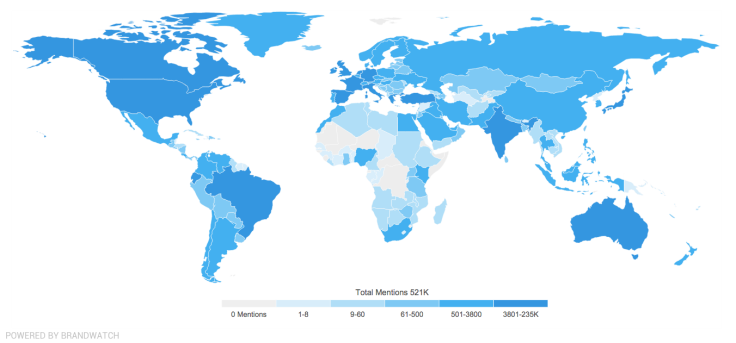A Comet Landing, Not Kim Kardashian Nude Photo Shoot, Broke The Internet

Kim Kardashian bared all for "Paper" magazine in an attempt to "#BreaktheInternet," but a little underdog 317 million miles away stole her spotlight. The European Space Agency's historic comet landing captivated Twitter users around the world, and the Rosetta mission had more mentions than the Kardashian photos, the Wall Street Journal reported.
The ESA's Rosetta mission launched in 2004 and consisted of two primary objectives: rendezvous with comet 67P/Churyumov-Gerasimenko and tag along as it travels around the sun, placing a lander on the comet. The space agency accomplished the first feat in August, after waking Rosetta up from three years of hibernation in January, and set the date for the first-ever soft-landing on a comet for Nov. 12. Rosetta was put into position around the comet and the Philae lander separated from the spacecraft as planned on Wednesday with later confirmation of a sucessful landing around 11 a.m. EST.
The historic mission soon went viral with #CometLanding trending worldwide on Twitter. Much like Curiosity's Twitter account, ESA gave Philae and Rosetta personalities on the social media platform that further endeared the mission to users around the world. Using Topsy to track mentions of the two Twitter hashtags associated with Kardashian's "Paper" magazine cover and the comet landing, as well as mentions of "comet" and "Kardashian," ESA's mission was more popular and better received than the sensational photos, notes WSJ.
ESA's comet landing had 479,434 tweets over 24 hours, beginning on Wednesday, compared to 307,782 for Kardashian. Expanding the mentions to include other hashtags, such as #Philae or #Touchdown, and the comet landing had more than 515,000 mentions on Twitter, according to Brandwatch.

Unfortunately, Philae could not properly drill into the comet after landing and bounced into a crevice which prevented the spacecraft from getting the necessary sunlight to recharge its batteries. The lander is currently in standby mode and was able to transmit its scientific data to Rosetta, which beamed it back to the ESA.
The data collected by Philae and Rosetta will be used in future comet and asteroid missions. While there are no plans to attempt to land another craft on a comet, the Japan Aerospace Exploration Agency, or JAXA, will attempt to land a small rover on a near-Earth asteroid in 2018. Hayabusa-2 is an asteroid explorer that will observe asteroid 1999JU3. As part of the mission, Hayabusa-2 has an asteroid impactor, colloquially dubbed a "space cannon," which will fire a small projectile at the asteroid to create an artifical crater. The asteroid explorer is scheduled to launch in December.
NASA has its own asteroid mission scheduled to launch in September 2016. The Origins Spectral Interpretation Resource Identification and Security-Regolith Explorer, or OSIRIS-REx, will collect samples from the asteroid Bennu and use its onboard scientific instruments to map the asteroid and determine its composition. Much like comets, asteroids are considered "building blocks" from when the solar system was first formed and could provide new insights into planet formation and the origin of life and water on Earth.
© Copyright IBTimes 2025. All rights reserved.






















